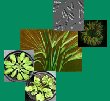| Beck, E: Biology of afroalpine Dendrosenecios (Asteraceae), Plant Systematics and Evolution, 152, 123-131 (1986), doi:10.1007/BF00985353 | |
| Abstract: The genusDendrosenecio (“giant groundsels”), encompassing three species and 12 subspecies, is endemic to the high mountains of East and Central Africa where it constitutes the most conspicuous components of the afroalpine vegetation. Two lifeforms, the arborescent and the prostrate rhizomatous, are regarded as the results of evolution from forest-living woody or herbaceous ancestors. Due to the uninterrupted growth period in the tropics, there are no anatomical or morphological features which allow conventional age determination. However, stem elongation rates have been determined (3–5.5 cm per year) and indicate an age of about 250 years for the tallest arborescent Dendrosenecios which may reach a height of 10 m. 30 to 120 large leaves are clustered in an enormous terminal rosette, justifying the term “giant rosette” plants. A leaf bud, consisting of about as many developing leaves as the rosette contains, is found in the center. During the nocturnal frost period the adult rosette leaves form a so-called night-bud by nyctinastic upwards bending and thus protect the leaf bud from freezing by insulation. The stem is surrounded by a mantle of persistent dead leaves; this ameliorates the microclimate of the pith-cells which greatly contribute to water transport into the leaves. Below the leaf rosette a zone of putrefaction is found, from where the decay of the dead leaves apparently provides nutrients directly to the growing stem. The population dynamics of the arborescentD. keniodendron is characterized by a simultaneous inflorescence development at irregular intervals of up to more than twenty years. Due to sporadic flowering and a seedling survival rate of less than 1%, oscillations of the population size are to be expected. |

Letzte Änderung 24.06.2020

